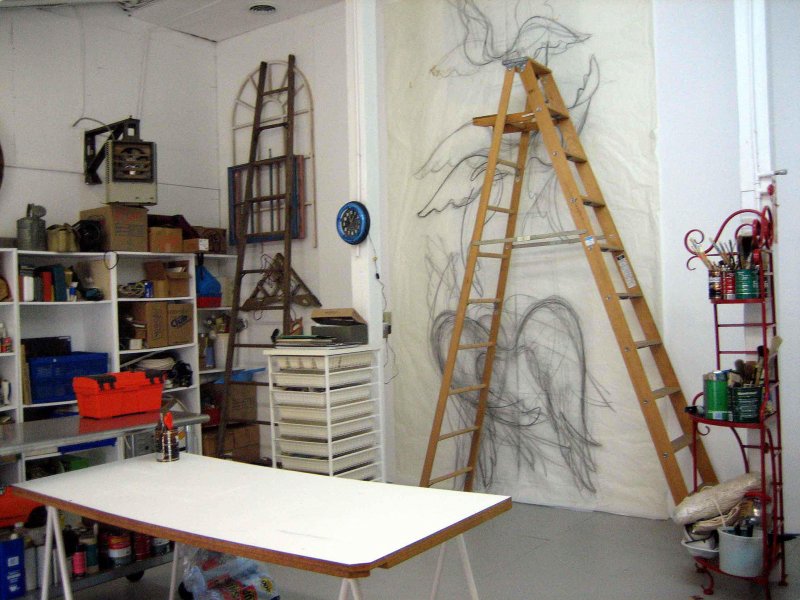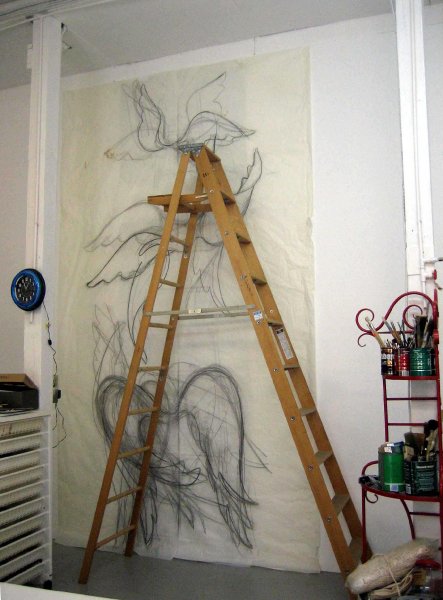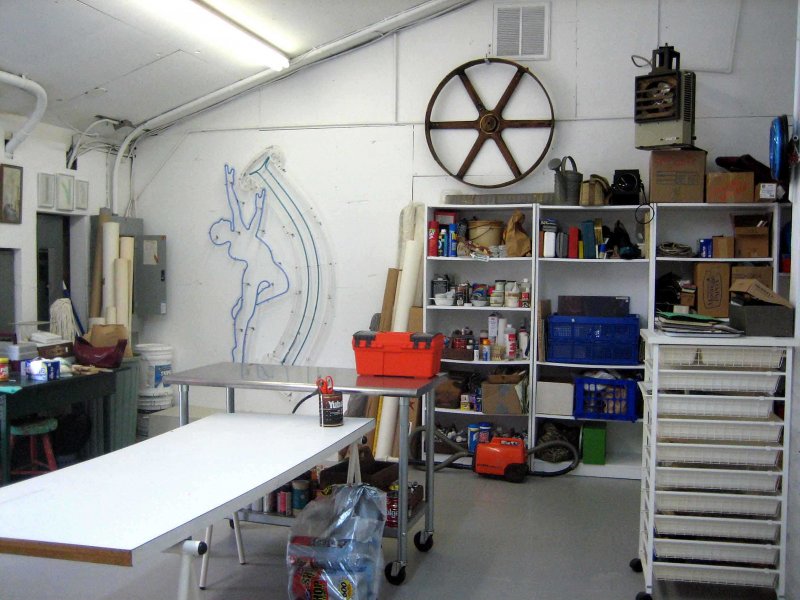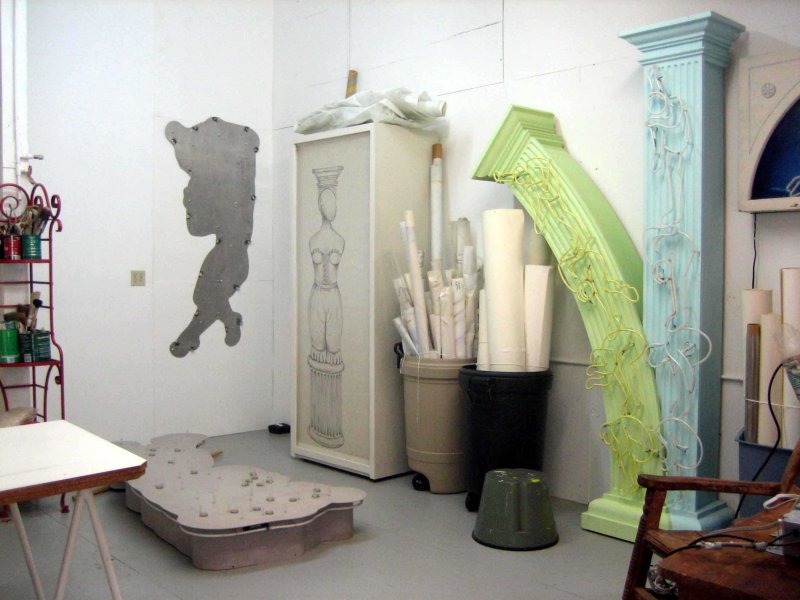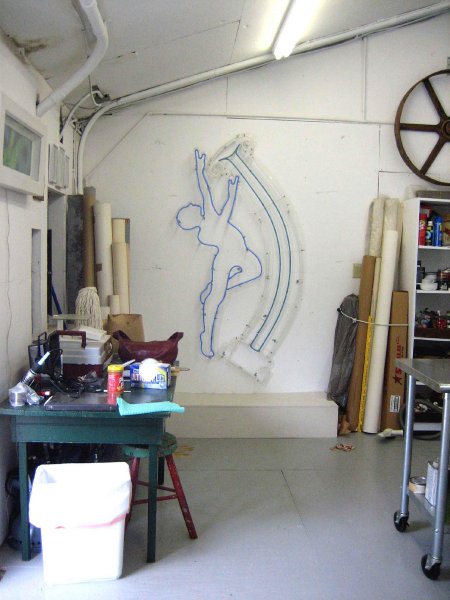“One Thing Leads to Another”
Tacked to the wall of my studio is a cartoon drawn by New Yorker cartoonist, Ed Koren, depicting several Stone Age groupies surrounding a Neolithic writer. “Where do you get your ideas?” they are asking him. That is the question everyone asks artists and writers, and one that is difficult to answer in twenty-five words or fewer at a church coffee hour or a cocktail party. When I am feeling smart-alecky, I reply that you need only one idea, because art is like sex. This insight was the result of a remark made by my mother, when, as a young teenager, I asked her if it was okay to hold hands with my first boyfriend. She responded, “One thing leads to another.” Indeed, it does!
My one idea sprang from a drawing exercise I set myself many years ago: to learn to draw the human figure in multiple positions by obsessively sketching the small, jointed wooden figure called the “lay” figure. As I could position it any way I liked in far more interesting configurations than I could coax out of an indifferent and languid model, and as I must have intuited from the beginning that I was more interested in a symbolic figure in motion than in a stationary live one, that repetitive exercise set me on my course and led to other things.
I cut out and sewed soft mannequins, stuffed them into wooden boxes, strung them up, stretched them on ladders, and made drawings of them. They were like still lifes, until the magical day they came to life and burst from confinement, leaping out of boxes and bouncing from nets. I called this work the Everyman Series, contrasting my liberated figures with mannequins created by artists such as DeChirico and DeKooning, who used them to symbolize mechanized man.
I acquired more lay figures and began to cut out the drawings I had made and assemble them into collages. I also cut out photographs of athletes and drew them as mannequins. I enlarged and shrank them in a photocopier. My studio was littered with dozens of little cutout figures. One day, I superimposed some of them into photographs, in the sky and over the heads of a crowd of people. Thus were born the inflatables. I set out to photograph the atriums of museums and government buildings, bought wide rolls of acid-free paper, and made large-scale charcoal and pastel drawings. These drawings introduced the element of architecture. In most subsequent work, the flying organic figures are constrained by the inorganic architecture they inhabit.
One fortuitous weekend, I visited a studio run by neon glass benders. One thing led to another, and soon I was airbrushing fluorescent figures onto friezes, pediments and columns, and making my first proposals for neon figures in post-modern architecture, sliding down columns, bursting from pediments, and tumbling along friezes.
In time, the neon figures acquired gender. The relationship of the figures to one another took precedence over liberation and animation. I inserted text into the work. In some instances, I combined neon with drawings on scrim. The increasing capability of computer programs such as Photoshop and Painter to digitally mimic an artist’s style, has meant that most new studies for neon have their genesis on the computer.
I also began a series, still in progress, of women icons or role models: Wonder Woman, Sleeping Beauty, Venus Rising from the Sea, with whom, as a woman seeking—humorously, and with tongue-in-cheek––to mobilize her full powers, I can identify. Fun to draw and funny, they reference myths, fairy tales, and comic books I relished as a young girl. Most of these drawings are large, but similar themes are explored in a small-scale Rubber Stamp series still underway.
Though my principal medium has always been drawing, and my focus, the human form, recent work blurs the boundary between drawing and painting. For years, I have made pen and watercolor drawings that trace my interior life and spiritual journey. I have scanned these into the computer, reworking and developing them in Photoshop and Painter. I also create some digital work directly on the computer screen. Much of this work is printed digitally as finished work, but some is further developed in paintings and mixed media. The drawings are filled with visual puns, and textual references to poems, hymns, and the bible. The figures, while remaining metaphorical, are no longer black and white mannequins, but colorful representations of inner selves and emotions, expressions of faith, despair, and joy.
To transition from generalized images of joy and transcendence to ones that express uninhibitedly and without sentimentality, the specificity of my Christian faith and the gratitude I feel for the gift of life, is a challenge to which I am bending such powers as I possess, confident that God, who began a good work in me, will bring it to completion.



